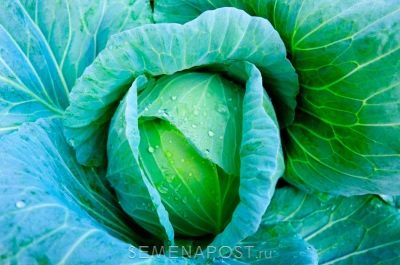
- Name synonyms: Lennox
- Year of approval: 1993
- Appointment: for fresh consumption, for all types of processing
- Leaf rosette: half-raised
- Leaf size: medium and large
- Leaf color: gray-green, with anthocyanin
- Sheet surface: concave, finely wrinkled
- Internal stump: short
- Weight, kg: 1,6-2,4
- Composition: dry matter 8.5%, total sugar - 5%, ascorbic acid - 41.7 mg per 100 g of raw matter, protein - 0.6%
Lennox is a white cabbage variety bred in 1993. This hybrid has both advantages and disadvantages, but there are much more of the former, so the variety is quite popular in the circles of Russian gardeners.
Description of the variety
It is a high-yielding variety for outdoor cultivation. The fruits retain their presentation for a long time, and this cabbage also tolerates drought and cold well. The pluses include unpretentious care, but summer residents also note one minus - during storage, some heads of cabbage become dryish.
Characteristics of the appearance of the plant and heads of cabbage
This variety has a semi-raised rosette of leaves, the leaves themselves can be medium or large in size, their surface is concave, finely wrinkled, the edges are smooth, and the color is usually gray-green, with anthocyanin.
Heads of cabbage weighing 1.6-2.4 kg have a round shape and have a short inner stump. Outside, the fruits are green, but inside they are white.
Purpose and taste
The heads of cabbage are very dense, consumers characterize their taste as excellent. Forks are used for fresh consumption, as well as for any kind of processing. This cabbage can be frozen, used for soup, stew, or as a pie filling.
Ripening terms
This is a late-ripening variety of cabbage. Heads of cabbage are removed at the stage of technical maturity, usually by this time the plant has an age of 167-174 days. Harvesting is usually in September.
Yield
Lennox belongs to high-yielding varieties and on average brings 454-1060 centners of vegetables per hectare. In order for the crop to be well preserved, it is recommended to plan harvesting on a dry day, when the temperature does not exceed +7 degrees. If the crop is harvested in rainy weather, then the fruits should be well dried before storing.
In order for the heads of cabbage to retain their presentation as long as possible, they are removed to a cool room, where the temperature is +2 degrees, and the humidity is 95%. This high humidity is needed so that the fruits do not become dry, which is typical for Lennox cabbage.
Growing and care
The optimal sowing time for seedlings is April, and sprouts are planted in open ground in May. The culture of this variety will feel more comfortable in loose loamy soil, which is rich in minerals. The area where the cabbage will be cultivated should be well lit by the sun. It is better to avoid ridges where radishes, turnips, pumpkins previously grew. More suitable predecessors are onions, cucumbers, potatoes, carrots.
Seedlings are planted according to the scheme 60x70 cm together with an earthen lump. Before planting, the planting pits should be abundantly moistened. The planted bushes are sprinkled with soil to the bottom leaf. Follow-up care consists of the following items.
- Watering. It is a moisture-loving variety. The culture should be watered twice a week with settled warm water, preferably rainwater.It is customary to carry out the procedure in the evening so that the moisture does not evaporate and the leaves do not get burned. Make sure that the jet is directed to the root. During the period of active growth, the plant needs to be watered in a larger volume, and when the fruits ripen, the frequency of moisture should be reduced.
- Loosening and hilling. After these manipulations, moisture and oxygen freely penetrate to the roots. Weeds are also removed during the procedure. The first hilling is carried out 20 days after transplanting the seedlings, after which the soil is loosened once every two weeks.
- Top dressing. The first top dressing is applied two weeks after planting in open ground. During this period, manure or bird droppings are suitable. The next fertilizer is used after another 14 days, now you can add nitrophosphate. The third feeding will be required in 2-3 weeks, this time droppings or manure can be mixed with potassium sulfate and superphosphate. It is important to feed the plant after irrigation.

To grow a rich cabbage crop, you need to know when and how to plant this crop outdoors. Planting dates are determined depending on the variety. It is also necessary to properly prepare the soil and follow the rules of crop rotation.



Cabbage requires particularly careful care when growing. The plant quickly absorbs nutrients, so the soil needs to be enriched regularly. Adequate amounts of minerals, organics and nitrogen must be provided. Some products can be purchased at the store, while others are easy to make at home.
Disease and pest resistance
Lennox is highly resistant to diseases such as fusarium wilt or bacteriosis, but can fall prey to cabbage keel. For this ailment, you can use the drugs "Previkur" or "Fundazol". Another common disease for culture is powdery mildew; Fitosporin-M will help get rid of it. If the plant is attacked by a cabbage fly, then Topaz, Mukhoed or Aktara preparations will be able to overcome it.

Cabbage is a very popular horticultural crop. But growing a good, large and tasty cabbage is sometimes very difficult, because it is often affected by a huge number of diseases and pests. The main role in the cultivation of this vegetable is played by regular prevention, which helps to get a rich harvest, and prevent the occurrence of diseases and the invasion of harmful insects. It is very important to start treatment as early as possible, otherwise there is a risk of spreading the infection to unaffected plants.























































































